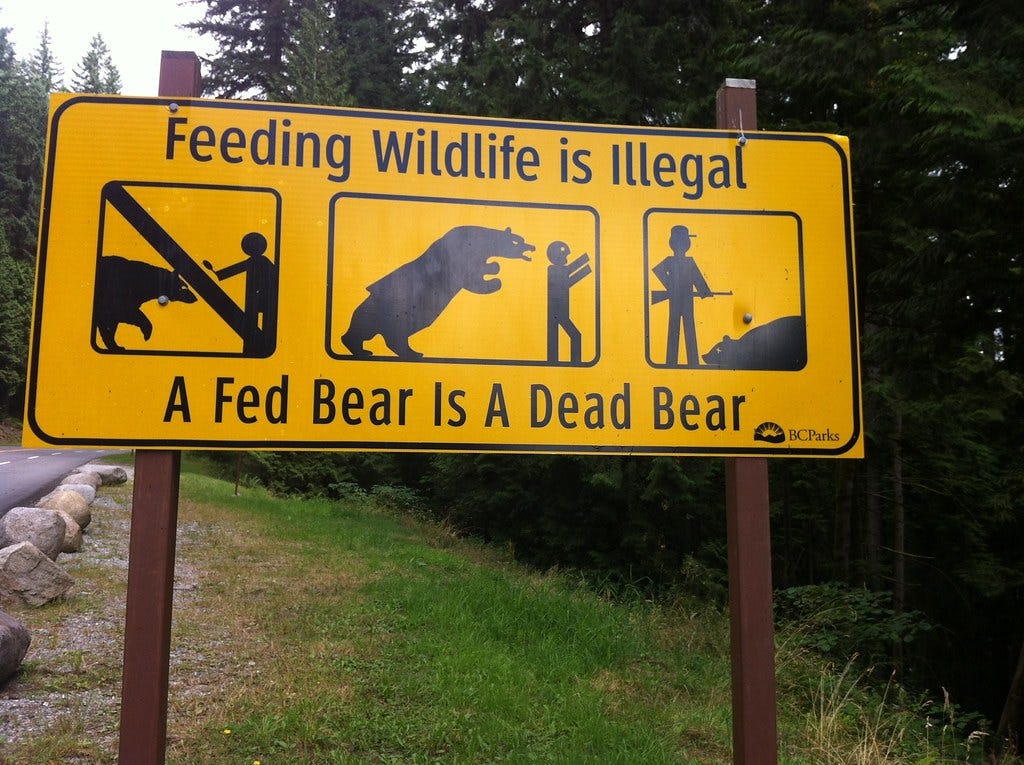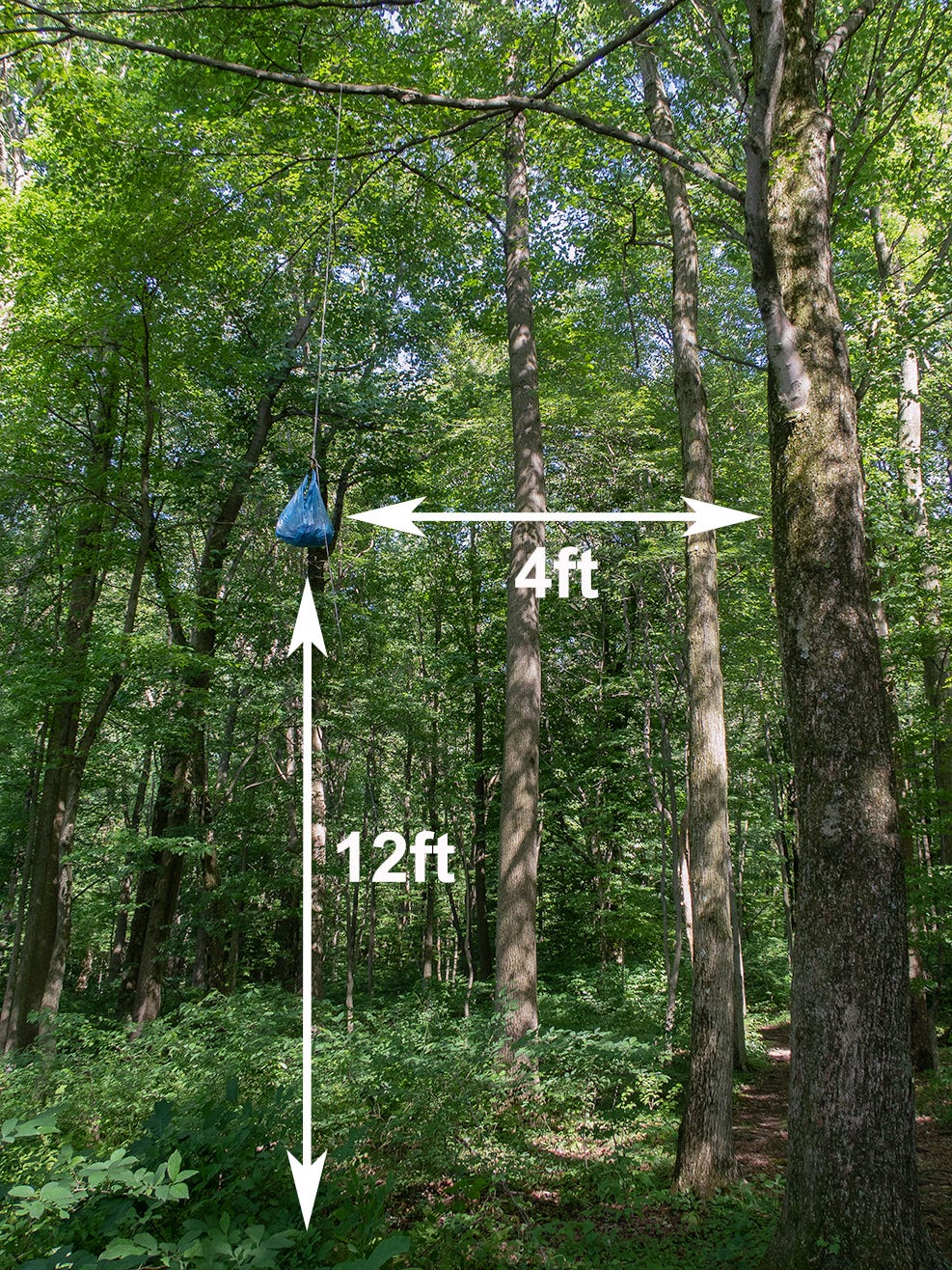Why are bear canisters required in some parks and not others?
Ursine Sunday
Ursine Sunday
Hi there, and welcome to Engineering Our Social Vehicles. I’m your host, Paul Logan. Today is Ursine Sunday. If you’re new in these parts, that means around here we like to spend our Sundays talking about bears. Today, we’re going to be talking about bear canisters.
Bear Resistant Food Containers (BRFCs)

Recently I posted a long article about a run in with some grizzlies in Glacier National Park. One of the undercurrents of the piece was that I’d brought along a bear bin, even though it wasn’t required, much to the amusement of locals.
For the uninitiated; “bear bin” is a nickname for a Bear Resistant Food Container. These are basically small portable vaults where you keep all of the smelly stuff in your pack- from food to sunscreen to chapstick. You keep it 100+ feet from your camp so that Yogi’s real-life cousins aren’t lured into your campsite while you sleep.
The reason that the locals in Montana found our BRFC funny is that none of the wilderness areas in the state have regulations mandating their use. Since these things are made to withstand a bear attack, they are often pretty heavy— adding 2-3 pounds to your pack. This is a gargantuan amount of weight for the “ultralight” hobbyist community; where people cut the ends off their toothbrushes in an effort to shave ounces.

So, when hikers see people carrying heavy bear bins around in places where it isn’t required, this is what they see:
Why keep food from bears?
Keeping your food bear-safe has the added benefit of keeping YOU bear-safe, since it often involves keeping food far from where you are sleeping. Bears that get food from humans pose a risk, as they can become habituated and seek humans out as a source of food. This raises the risk of bear attacks, and as such it is blanket policy to euthanize bears that have been fed, or manage to get food from campsites.
Hence the classic slogan rattled off by every ranger:
“A fed bear is a dead bear.”
Bear hangs: the alternative
Instead of carrying a bin, most hikers would rather carry rope and a smell-proof food bag that they can hang in a tree.
If you’re from the generation of hikers before bear bins, or are used to always having trees around, bear bins seem silly or ridiculous.
However, if you’ve done any amount of west-coast alpine hiking, you know that you’re often camping over treeline. On the PCT you have to use a bin on and off throughout California. Andrew Skurka lists this and other reasons in his piece on why hangs are often problematic; the comments on it give a good example of the division bear bins cause in the outdoors community.
In Glacier, they’ve solved the tree problem by erecting iron bars to hang from. When we asked about just using a bin instead, the rangers said we should still bring 25 feet of rope to tie the bin down so a grizzly wouldn’t just walk away with it.
The ranger’s comments, plus the comments of various hikers we ran into in the backcountry, and others online like “Maybe bear cans work for black bears, but they’re just a puzzle for grizzly” all add up to suggest there’s a general misconception that BRFC’s don’t work on grizzlies. I’d like to set that record straight.
Bear bins stop grizzlies
If a bear can is certified, it is certified on grizzlies. I can see where the misconception might come from, considering that there are no grizzlies in CA, which notoriously requires bear bins, but many in MT- which doesn’t. I heard this reasoning repeated once or twice in Glacier for why it was stupid to carry a bin.
This got me curious, so I decided to look into it. Here are the BRFC regulations for every national park with a grizzly population:
Mandatory in Katmai (AK)
Required in Denali (AK)
Optional in Kenai (AK)
So it seems like out of the 10 National Parks that have grizzlies, 5 require them, 2 recommend them, and 3 don't differentiate between a BRFC and hanging as proper storage.
For the life of me I can't tell what this split is. It certainly isn't geographic. I guess I have to accept that it just comes down to what that specific park's administration has decided. Which leads me to the question: how does a specific park’s administration decide to require bear bins? It doesn’t seem to be related to bear attacks.
Bear attacks and BRFC requirments
I want to add a disclaimer here that this data isn’t granular enough to draw any firm conclusions. That said, both Yellowstone and Glacier hold the records for bear fatalities in national parks, and neither distinguish between hanging and BRFC’s for food storage. Here’s a map of bear fatalities by state from 1900-2016:

For comparison, here are the states with at least one wilderness area requiring BRFC’s:

Every incident is unique, and many aren’t at all related to food storage, so this isn’t a great comparison. If anything, I think analysis should be done looking at the relation between policy around bear-safe food storage and park administration stance on bear safety.
Going back to Glacier and Yellowstone, they also happen to be some of the most popular and car-friendly national parks, which puts uninformed frontcountry tourists in contact with wild animals at a higher rate. Less car-friendly parks create a higher barrier to entry, meaning the people who do encounter bears are likely more informed and prepared.
The national stance on bears was redefined in August 1967 when Glacier had two fatal bear attacks in the same night, only about 10 miles apart. The narrative eventually landed on exposure to human food and garbage, and the event became the impetus for the bear-proof trash cans in almost every national park to this day.
The slow march of BRFC’s into the kit of backcountry hikers is a repetition of this drama on a smaller stage. Even the Continental Divide Trail lists bear cans as required in Glacier, despite the park’s rules stating otherwise.
What determines BRFC requirements?
Since it definitely isn’t geography, bear attacks, deaths, or frequency of encounters; I’m left wondering how parks determine their BRFC requirements. It seems that each park has been left to decide backcountry food storage requirements for themselves. Without a national standard, we’re left trusting the rules of individual park’s administrators.
After visiting Glacier and studying their rules, I think they make sense: The park’s rules explicitly allow hanging only from their designated pole system. If it isn’t hanging from the poles, it needs to be in an otherwise bear-safe container, which means an approved BRFC or one of the permanent bins installed at some sites.
However, I can’t speak for other parks. As a matter of policy left up to the administration of the park itself- there’s no rhyme or reason. Even in Glacier, you aren’t guaranteed to be around a set of poles to hang should you need to camp in an emergency. In this case, a bear bin could be a life-saver.
Conclusion
I think eventually bear bins will be universally encouraged, especially for parks without a hang system like Glacier. For now, hikers will continue to ridicule bins as ridiculous wastes of weight and space, and refuse to use them when they aren’t required to. Until there’s any sort of national consensus among park administration, the community will be divided in taking BRFC’s seriously.
Do you think there should be a national standard around when BRFC’s are required? Let me know in the comments, or shoot me a tweet @laul_pogan.








I really liked having that bear bin with us in Glacier... when you were carrying it. Nice article dude very informative 👍